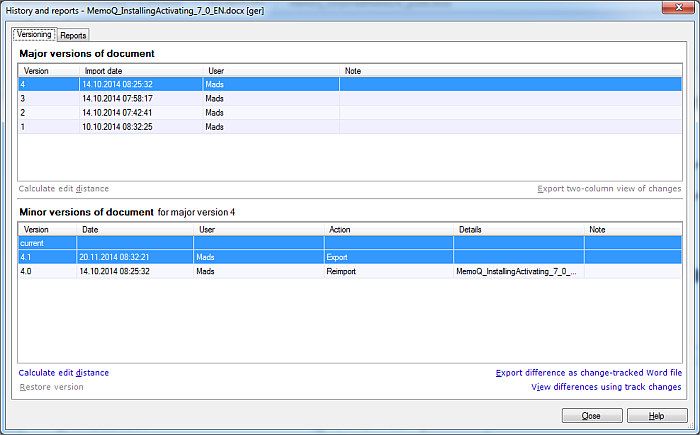|
The History and reports dialog allows you to compare two source or target versions of the same document, or allows you to see all reports relating to a document. The History and reports dialog consists of two tabs, Versioning and Reports.
How to beginSelect a document on the Translations pane of Project home, and click the Versions button on the Documents ribbon tab, then choose History/Reports. Alternatively, right-click on the document's name and select History/Reports. The Versioning tabThe Versioning tab contains two sections: Major versions of document and Minor versions of document. The contents of the Minor versions of document section depend on the major version, and change if you select a different major version from the upper list. The Major versions of document section contains the following information: •Version. The major version of the document. Increments by one with every reimport. •Import date. The time the document was imported or reimported. •User. The user who imported or reimported the document into the project. •Note. If the user added a note, the text of the note (optional). Select two major versions and click Export two-column view of changes to create an HTML table with the differences between two major versions. This will create an HTML file that you can open in a web browser. The HTML file consists of two parts: the change summary and the table view. The change summary contains the number of segments that remained unchanged, the number of nearly identical segments, the number of segments that disappeared and the number of newly added segments. Nearly identical segments are identical with the sole exception that their inline tag attributes differ. This is automatically adjusted by memoQ from the translation memory. If a segment is changed, that qualifies as a disappeared and newly added segment. The word and character counts indicate the number of words and characters in the same category. The table view shows the entire document in a grid. Segments next to each other, with a transparent background mean segments that remained identical. A beige background indicates nearly identical segments - they are always next to each other -, whereas new segments appear in blue on the right, deleted segments appear in pink on the left. This is a visual overview of the changes. The Minor versions of document section contains the following information: •Version. The major and minor version of the document. Increments by one with every new snapshot, manual or automatic minor version creation. Cases where minor versions are not created: resegmentation after adding a new abbreviation; in local copies of a checked out online project (no snapshot creation possible in local projects); •Date. The time the minor version was created. •User. The user who created the minor version. •Action. The action that created a minor version. It can be, among other things, a snapshot, a deliver, a bilingual export, a bilingual import, etc. •Details. Further details of the action where appropriate. •Note. If the user added a note, the text of the note (optional). Select two minor versions and click View differences using track changes to compare the differences between the two selected minor versions. This will open a document editor that shows the differences between two versions in a way that is familiar from Microsoft Word. You can only edit this document if you compared a version with the current version. Otherwise it is read-only. Select the Restore version command link, when one minor version is selected and is not the live revision, to create a new minor version whose content is identical to the selected minor version. Select the Export difference as change-tracked Word file command link to export changes into a Word document. Select the Calculate edit distance command link after you selected 2 documents to generate a edit distance report for either a major or minor document version. The calculation is based on the target segments of the 2 selected versions. The Reports tabThe Reports tab shows all the reports that relate to this file. The reports include progress reports, analysis, and post-translation analysis. These reports show the file-specific part of the general reports that you can create on the Reports tab of the Overview pane. You can export any report into CSV format by using Export report. You can display any report in the lower part of the dialog by selecting it in the upper part of the dialog.
NavigationClick Close to close the History and reports dialog. Note: This functionality is only available in the project manager edition of memoQ. |

